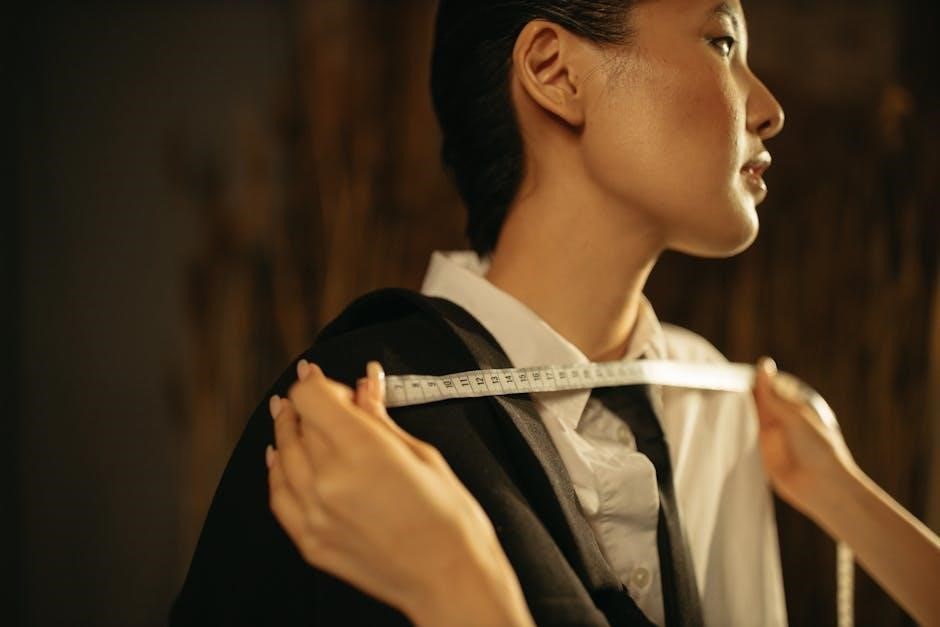A clothing measurement guide helps ensure proper fit by providing standardized sizing references. It assists in selecting garments that align with individual body measurements, addressing diverse body types and styles. Accurate measurements are essential for avoiding sizing issues and enhancing confidence in purchasing decisions.
1.1 Importance of Accurate Measurements
Accurate measurements are crucial for ensuring a proper fit, reducing the likelihood of returns, and minimizing the need for alterations. They help individuals select garments that flatter their body type, boosting confidence and satisfaction. Precise measurements also enable seamless online shopping experiences, as they bridge the gap between sizing charts and personal fit preferences. Taking the time to measure correctly ensures a better fit and a more enjoyable shopping process.
1.2 Purpose of a Clothing Measurement Guide
A clothing measurement guide serves as a practical tool to help individuals determine their correct clothing size. It provides clear instructions on how to measure various parts of the body and correlates these measurements with standard size charts. The guide aims to eliminate sizing confusion, ensuring that garments fit well and meet personal style preferences. By using a measurement guide, shoppers can make informed purchasing decisions, whether online or in-store.
Understanding Body Measurements
Body measurements are essential for determining clothing sizes. They involve measuring key areas like bust, waist, hips, and inseam to ensure proper fit and style alignment;
2.1 Key Body Measurements for Clothing
Key body measurements include chest, waist, hips, and inseam. These measurements help determine clothing sizes accurately. Chest size is measured around the fullest part of the bust. Waist is measured at the narrowest point. Hips are measured 7-9 inches below the waist. Inseam is the length of the inside of the leg. Accurate measurements ensure proper fit and comfort. Using a flexible tape measure and keeping it level is crucial for precise results.
2.2 How to Measure Chest Size
To measure chest size, wrap a flexible tape measure around the fullest part of your chest. Stand up straight with your arms at your sides. The tape should be level and parallel to the floor, not too tight or loose. Place the tape just under your armpits and across your nipple line. Breathe naturally and take note of the measurement. This ensures an accurate fit for shirts, jackets, and other garments. Repeat the process to confirm consistency.
2.3 How to Measure Waist Size
To measure your waist size, locate the narrowest point of your torso, typically just above your hipbone and below your ribcage. Stand upright and relax your stomach muscles. Wrap the tape measure around your natural waistline, keeping it level and parallel to the floor. Avoid pulling the tape too tight or leaving it too loose. Breathe naturally and record the measurement. Double-check to ensure accuracy for the best fit in pants, skirts, and dresses.
2.4 How to Measure Hip Size
To measure your hip size, stand upright and identify the widest part of your hips, usually 7-9 inches (18-23 cm) below your waistline. Wrap the tape measure around this area, ensuring it’s level and parallel to the floor. Keep your legs slightly apart and relax your muscles. Avoid pulling the tape too tight or letting it sag. This measurement is crucial for determining the best fit in pants, skirts, and dresses. Accuracy ensures comfort and proper tailoring.
2.5 How to Measure Inseam
Stand upright and place the tape measure at the top of your inner thigh, where your legs meet. Ensure the tape is snug but not tight, then extend it straight down to your ankle bone. Keep your legs slightly apart and your muscles relaxed. This measurement determines pant length, ensuring a proper fit. Avoid pulling the tape too tight or allowing it to sag, as this can lead to inaccurate sizing. Precision is key for optimal comfort and style.

How to Measure Accurately
Accurate measurements require a flexible tape measure, proper posture, and consistent landmarks. Ensure the tape lies flat, isn’t twisted, and aligns with key body points for precise results.
3.1 Preparing for Measurement
Preparing for accurate clothing measurements involves using a flexible tape measure and ensuring proper posture. Wear minimal, form-fitting clothing or undergarments. Stand upright with feet shoulder-width apart and relax your muscles. Keep the tape measure flat and untwisted, ensuring it aligns with key anatomical landmarks. Use a full-length mirror to monitor positioning. Proper preparation ensures consistency and accuracy, helping to avoid common measurement errors and providing reliable data for clothing size determination.
3.2 Tips for Taking Precise Measurements
For precise clothing measurements, use a flexible tape measure and ensure proper posture. Stand upright, relax your muscles, and avoid twisting. Measure in front of a mirror to maintain visibility. Keep the tape measure flat and untwisted, aligning it with anatomical landmarks; Do not pull the tape too tight or hold your breath. Take multiple measurements to confirm accuracy, and consider having someone assist you for harder-to-reach areas. Consistency is key for reliable results.

Standard Clothing Sizes
Standard clothing sizes provide a consistent framework for selecting garments based on body measurements, ensuring a good fit across different brands and styles.
4.1 Understanding Men’s Clothing Sizes
Men’s clothing sizes are typically based on chest measurements, with standard sizes ranging from Small to XXXL. These sizes vary slightly between regions, such as US, EU, and UK standards. Understanding these differences helps in selecting the right fit. Accurate measurements ensure comfort and proper fit, reducing the need for alterations or returns. Always refer to the specific size chart for the brand or region to make informed purchasing decisions.
4.2 Understanding Women’s Clothing Sizes
Women’s clothing sizes vary by region and brand, with sizes often based on bust, waist, and hip measurements. Standard sizes range from XS to XXXL, but fit can differ due to varying body types. Accurate measurements are crucial for selecting the right size, ensuring comfort and confidence. Always consult the specific size chart for the brand or region to avoid sizing discrepancies and ensure the best fit for your body type.
4.3 Understanding Children’s Clothing Sizes
Children’s clothing sizes are typically based on age and height, but body proportions can vary widely. Sizes may differ between brands, so consulting specific size charts is essential. Measurements such as chest, waist, and inseam are crucial for accurate sizing. Regular measuring is recommended as children grow quickly. Using both age and body measurements ensures the best fit, providing comfort and confidence for kids while addressing their unique growth patterns and needs.

Converting Measurements to Clothing Sizes
Converting measurements to clothing sizes involves comparing body measurements to standard size charts. This ensures proper fit and alignment with personal fit preferences, enhancing comfort and style.
5.1 How to Determine Your Clothing Size
Determining your clothing size begins with accurate body measurements. Compare your measurements to a size chart, ensuring alignment with your chest, waist, and hip sizes; Standard charts provide a baseline, but variations exist across brands. Always consult the specific brand’s sizing guide for precise fit. This step ensures proper fit and alignment with personal preferences, reducing the need for alterations or returns.
5.2 Adjusting for Fit Preferences
Once your size is determined, adjust based on personal fit preferences. For a relaxed fit, select a larger size, while a tailored look requires a closer match. Consider fabric type and stretch for comfort. Some brands offer slim or loose fits, so review their specific sizing notes. Adjustments ensure the garment meets your comfort and style expectations, enhancing overall satisfaction with the purchase.

The Importance of Accurate Measurements
Accurate measurements ensure proper fit, boosting confidence and satisfaction. They minimize returns and alterations, saving time and resources for both consumers and retailers.
6.1 Ensuring Proper Fit
Accurate measurements are crucial for ensuring clothing fits perfectly, enhancing both comfort and appearance. Proper fit prevents garments from being too tight or loose, addressing diverse body types. Key measurements like chest, waist, hips, and inseam guide tailored sizing. Without precise data, clothes may not align with body contours, leading to discomfort or unflattering silhouettes. Using a measurement guide ensures optimal fit, making fashion choices more satisfying and confident.
6.2 Reducing Returns and Alterations
Accurate measurements significantly reduce the need for returns and alterations by ensuring garments fit correctly. Proper sizing minimizes discrepancies, saving time and resources. Customers benefit from receiving well-fitting clothes, while retailers see fewer returns, improving operational efficiency. This streamlined process enhances customer satisfaction and reduces costs associated with adjustments or exchanges, making it a win-win for both parties involved in the purchasing process.

International Clothing Size Charts
International clothing size charts vary by region, with different standards in the US, EU, UK, and Australia. Standardized measurements help reduce fit inconsistencies and sizing confusion globally.
7.1 US Clothing Size Standards
US clothing size standards are based on specific body measurements to ensure consistency across brands. They vary for men, women, and children, with detailed sizing charts for accurate fit. Key measurements include chest, waist, hips, and inseam. While there is some variation between brands, these standards help consumers select garments that match their body dimensions. Standardization reduces sizing errors and simplifies shopping experiences, both online and in-store.
7.2 EU Clothing Size Standards
EU clothing size standards are based on body measurements, similar to the US system but with slight variations. They use numerical sizing for men, women, and children, ensuring consistency across brands. For example, men’s sizes often start at 40, while women’s sizes begin at 34. These standards aim to provide accurate fits and simplify shopping experiences. However, slight differences may exist between brands, so comparing measurements is essential for the best fit.
7.3 UK and Australian Clothing Size Standards
UK and Australian clothing sizes differ slightly from US standards, often running smaller. For example, a UK size 12 is equivalent to a US size 8. Both countries use numerical sizing for men, women, and children, aiming to provide consistent fits. However, variations exist between brands. Australian sizes align closely with UK standards but may have minor differences. Always check specific measurement charts to ensure the best fit, as cutter and vanity sizing can vary.

Common Measurement Mistakes
Common measurement mistakes include using a rigid tape, measuring over clothing, inconsistent posture, and not keeping the tape measure level, leading to inaccurate sizing.
8.1 Avoiding Measurement Errors
To avoid measurement errors, use a flexible tape measure and ensure it’s level and not twisted. Measure without clothing or with thin garments, maintaining natural posture. Avoid pulling the tape too tight or loose. Double-check each measurement, and consider having someone assist for accuracy. Consistency is key to reliable results, helping ensure the best fit possible. Accurate measurements are fundamental for proper sizing and a successful shopping experience.
8.2 Best Practices for Measuring
For accurate measurements, use a flexible tape measure and ensure it’s level and untwisted. Measure over thin clothing to reflect your body shape. Keep your posture natural—stand tall with feet shoulder-width apart. Avoid pulling the tape too tight or loose, as this can skew results. Consistency is key to achieving reliable measurements. By following these practices, you’ll ensure precise sizing, a smoother shopping experience, and confidence in your fit.
A clothing measurement guide is an essential tool for ensuring proper fit and confidence in clothing choices. By following best practices, you can achieve accurate measurements and enjoy a seamless shopping experience with well-fitting garments.
9.1 Summary of Key Points
A clothing measurement guide provides essential tools for accurate sizing, ensuring proper fit and confidence in purchases. By understanding body measurements, standard sizes, and international charts, individuals can make informed decisions. Accurate measurements reduce returns and alterations, while proper fit enhances comfort and style. This guide offers comprehensive insights, helping users navigate sizing challenges and achieve the best possible fit for their unique body type and personal style preferences.
9.2 Final Tips for Using a Measurement Guide
For the best experience, update your measurements regularly and double-check them before shopping. Use a flexible tape measure and consider fit preferences. Compare your measurements to size charts for accuracy. If unsure, consult sizing guides specific to brands or regions. Prioritize comfort and personal style to ensure satisfaction with your purchases. Regularly reviewing and adjusting your approach will help you master the use of a clothing measurement guide effectively.